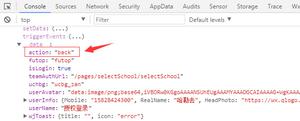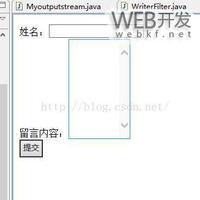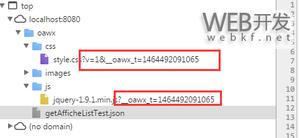Servlet Filter过滤器执行顺序
Servlet中的过滤器相当于守护后台资源的一道关卡,我们可以在过滤器中进行身份校验、权限认证、请求过滤等。
过滤器本身并不难,我们只需要知道他的定义方法、作用范围、执行顺序即可。
网上对于过滤器执行顺序的描述可能会让人产生误解。
图片来源于网络
客户端请求到达的时候,经过一次过滤器。
服务器处理完请求的时候,经过一次过滤器。
虽然经过两次过滤器,但不代表同样的代码执行了两次。
下面做了个简单的测试,看下执行结果就应该知道真正的执行流程了。
测试环境
tomcat9(servlet4.0)
jdk1.8
新版servlet可以通过注解注册servlet组件以及过滤器,无需再到web.xml下注册了。
测试过程
测试之间要先知道filterChain(过滤链)是干嘛的。
一个过滤器处理完后,会把request和response对象通过filterchain传递给下一个过滤器,如果没有下一个过滤器,则会直接开始执行业务代码,
单个过滤器
定义一个过滤器A
@WebFilter(value = "/*", filterName="A")
public class FilterA implements Filter {
@Override
public void doFilter(ServletRequest request, ServletResponse response, FilterChain chain)
throws IOException, ServletException {
SimpleDateFormat format = new SimpleDateFormat("yyyy-MM-dd HH:mm:ss");
System.out.println(format.format(new Date()));
System.out.println("A:拦截1");
chain.doFilter(request, response);
System.out.println(format.format(new Date()));
System.out.println("A:拦截2");
}
@Override
public void init(FilterConfig filterConfig) throws ServletException {
}
@Override
public void destroy() {
}
}
定义一个servlet,sleep5秒
@WebServlet("/mainUrl")
public class MainController extends HttpServlet {
private static final long serialVersionUID = 1L;
/**
* @see HttpServlet#HttpServlet()
*/
public MainController() {
super();
// TODO Auto-generated constructor stub
}
/**
* @see HttpServlet#doGet(HttpServletRequest request, HttpServletResponse response)
*/
protected void doGet(HttpServletRequest request, HttpServletResponse response) throws ServletException, IOException {
// TODO Auto-generated method stub
try {
Thread.sleep(5000);
} catch (InterruptedException e) {
// TODO Auto-generated catch block
e.printStackTrace();
}
}
/**
* @see HttpServlet#doPost(HttpServletRequest request, HttpServletResponse response)
*/
protected void doPost(HttpServletRequest request, HttpServletResponse response) throws ServletException, IOException {
// TODO Auto-generated method stub
doGet(request, response);
}
}
运行结果
2020-12-01 10:46:50
A:拦截1
2020-12-01 10:46:55
A:拦截2
执行顺序:
filterChain之前的代码 ——>业务处理——>filterChain之后的代码。
多个过滤器
servlet的注解在多个过滤器的情况下,是按照过滤器的名称来排序的,例如A开头的过滤器,在B开头的后面。
A过滤器
@WebFilter(value = "/*", filterName="A")
public class FilterA implements Filter {
@Override
public void doFilter(ServletRequest request, ServletResponse response, FilterChain chain)
throws IOException, ServletException {
SimpleDateFormat format = new SimpleDateFormat("yyyy-MM-dd HH:mm:ss");
System.out.println(format.format(new Date()));
System.out.println("A:拦截1");
chain.doFilter(request, response);
System.out.println(format.format(new Date()));
System.out.println("A:拦截2");
}
@Override
public void init(FilterConfig filterConfig) throws ServletException {
}
@Override
public void destroy() {
}
}
B过滤器
@WebFilter(value = "/*", filterName="B")
public class FilterB implements Filter{
@Override
public void doFilter(ServletRequest request, ServletResponse response, FilterChain chain)
throws IOException, ServletException {
// TODO Auto-generated method stub
SimpleDateFormat format = new SimpleDateFormat("yyyy-MM-dd HH:mm:ss");
System.out.println(format.format(new Date()));
System.out.println("B:拦截1");
chain.doFilter(request, response);
System.out.println(format.format(new Date()));
response.setContentType("normal content");
System.out.println("B:拦截2");
}
@Override
public void init(FilterConfig filterConfig) throws ServletException {
}
@Override
public void destroy() {
}
}
运行结果:
2020-12-01 10:53:00
A:拦截1
2020-12-01 10:53:00
B:拦截1
2020-12-01 10:53:05
B:拦截2
2020-12-01 10:53:05
A:拦截2
执行顺序:
B:拦截1和B:拦截2之间,停顿了5秒处理业务。所以先执行了 chain.doFilter前的 A、B过滤器代码,处理完业务返回的时候正好相反,先返回执行B的代码,再执行的A的代码。
总结
再来看这个图,可以略微改一下了。
分界线是filterChain过滤链,请求进来的时候,执行filterchain之前的代码,返回response的时候,执行filterchain之后的代码。
多个过滤器之间的执行顺序,满足“先进后出” (栈结构)的原则。
其他
如果在测试过程中,发现过滤器执行了很多次,那么也可能是因为测试环境中包含了某些静态资源。
过滤器A
@WebFilter(value = "/*", filterName="A")
public class FilterA implements Filter {
@Override
public void doFilter(ServletRequest request, ServletResponse response, FilterChain chain)
throws IOException, ServletException {
SimpleDateFormat format = new SimpleDateFormat("yyyy-MM-dd HH:mm:ss");
System.out.println(format.format(new Date()));
System.out.println("A:拦截1");
chain.doFilter(request, response);
System.out.println(format.format(new Date()));
System.out.println("A:拦截2");
}
@Override
public void init(FilterConfig filterConfig) throws ServletException {
}
@Override
public void destroy() {
}
}
过滤器B
@WebFilter(value = "/*", filterName="B")
public class FilterB implements Filter{
@Override
public void doFilter(ServletRequest request, ServletResponse response, FilterChain chain)
throws IOException, ServletException {
// TODO Auto-generated method stub
HttpServletRequest req = (HttpServletRequest) request;
SimpleDateFormat format = new SimpleDateFormat("yyyy-MM-dd HH:mm:ss");
System.out.println(req.getRequestURL());
System.out.println(format.format(new Date()));
System.out.println("B:拦截1");
chain.doFilter(request, response);
System.out.println(format.format(new Date()));
response.setContentType("normal content");
System.out.println("B:拦截2");
}
@Override
public void init(FilterConfig filterConfig) throws ServletException {
}
@Override
public void destroy() {
}
}
主程序
@WebServlet("/mainUrl")
public class MainController extends HttpServlet {
private static final long serialVersionUID = 1L;
/**
* @see HttpServlet#HttpServlet()
*/
public MainController() {
super();
// TODO Auto-generated constructor stub
}
/**
* @see HttpServlet#doGet(HttpServletRequest request, HttpServletResponse response)
*/
protected void doGet(HttpServletRequest request, HttpServletResponse response) throws ServletException, IOException {
// TODO Auto-generated method stub
try {
Thread.sleep(5000);
} catch (InterruptedException e) {
// TODO Auto-generated catch block
e.printStackTrace();
}
request.getRequestDispatcher("/WEB-INF/pages/main.jsp").forward(request, response);
// response.sendRedirect("/WEB-INF/pages/main.jsp");
}
/**
* @see HttpServlet#doPost(HttpServletRequest request, HttpServletResponse response)
*/
protected void doPost(HttpServletRequest request, HttpServletResponse response) throws ServletException, IOException {
// TODO Auto-generated method stub
doGet(request, response);
}
}
执行结果:
2020-12-01 11:09:38
A:拦截1
http://localhost:8080/StudentManage/mainUrl
2020-12-01 11:09:38
B:拦截1
2020-12-01 11:09:43
B:拦截2
2020-12-01 11:09:43
A:拦截2
2020-12-01 11:09:44
A:拦截1
http://localhost:8080/StudentManage/css/bootstrap.css.map
2020-12-01 11:09:44
B:拦截1
2020-12-01 11:09:44
B:拦截2
2020-12-01 11:09:44
A:拦截2
转发(forward)的页面中需要请求静态资源,再次触发了过滤器。
以上是 Servlet Filter过滤器执行顺序 的全部内容, 来源链接: utcz.com/z/327768.html







